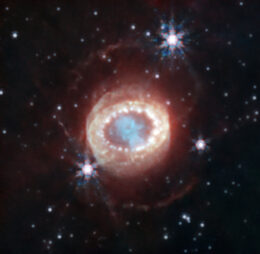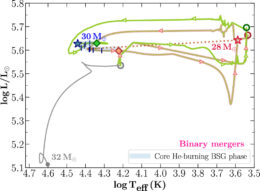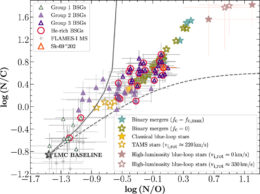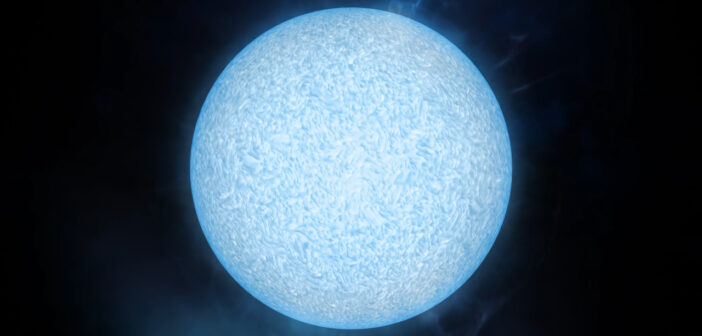New research shows that the properties of some blue supergiant stars can be explained by the merger of a massive star with a smaller companion. This suggests that many of the brightest and hottest stars in our galaxy are not born, but made.
One Star or Two?

JWST image of SN 1987A. Some research suggests that the intricate ejecta pattern could not be possible without the supernova progenitor star undergoing a merger. [NASA, ESA, CSA, Mikako Matsuura (Cardiff University), Richard Arendt (NASA-GSFC, UMBC), Claes Fransson (Stockholm University), Josefin Larsson (KTH)]
Researchers have applied this line of thinking to several famous massive stars like Eta Carinae and the progenitor of the supernova SN 1987A, showing that the merger model explains these stars’ unusual properties. Now, a research team led by Athira Menon (Institute of Astrophysics of the Canary Islands and University of La Laguna) has taken the investigation a step further, using this model to explain the varied properties of a population of blue supergiant stars in a neighboring galaxy.

Evolutionary track for the merger product of a 31.6-solar-mass star and a 3.2-solar-mass star. [Menon et al. 2024]
A Star Is Made
Menon’s team used the Modules for Experiments in Stellar Astrophysics (MESA) to model the evolution of post-merger stars and to compare the properties of blue supergiants coming from single stars to those coming from stellar mergers.
In the stellar merger scenario, blue supergiants result from the collision of a massive post-main-sequence star and its main-sequence binary companion. As the massive star expands, it donates some of its mass to its companion, which eventually becomes entangled in the extensive outer atmosphere of the larger star. Doomed by friction and tidal forces, the smaller star “dissolves” within the larger star, setting the resulting star on a new evolutionary path.
Clues from Chemical Abundances
The team found that blue supergiants formed through mergers have different surface abundances of elements like carbon and oxygen compared to supergiants arising from single stars. To compare these results to the properties of actual blue supergiants, the team amassed a sample of 59 blue supergiant stars in the Large Magellanic Cloud and divided them into three groups based on the ratios of their carbon, nitrogen, and oxygen abundances.

Chemical abundance ratios for modeled stars (star icons) and observed blue supergiants (BSGs; triangles). Click to enlarge. [Menon et al. 2024]
Taking into account other factors, such as systematic offsets, Menon’s team concluded that more than half of the 59 stars in their sample came from stellar mergers. This suggests that many blue supergiant stars owe their status to a stellar merger, and the merger model is a valuable tool to understand blue supergiant populations throughout the universe.
Citation
“Evidence for Evolved Stellar Binary Mergers in Observed B-type Blue Supergiants,” Athira Menon et al 2024 ApJL 963 L42. doi:10.3847/2041-8213/ad2074

